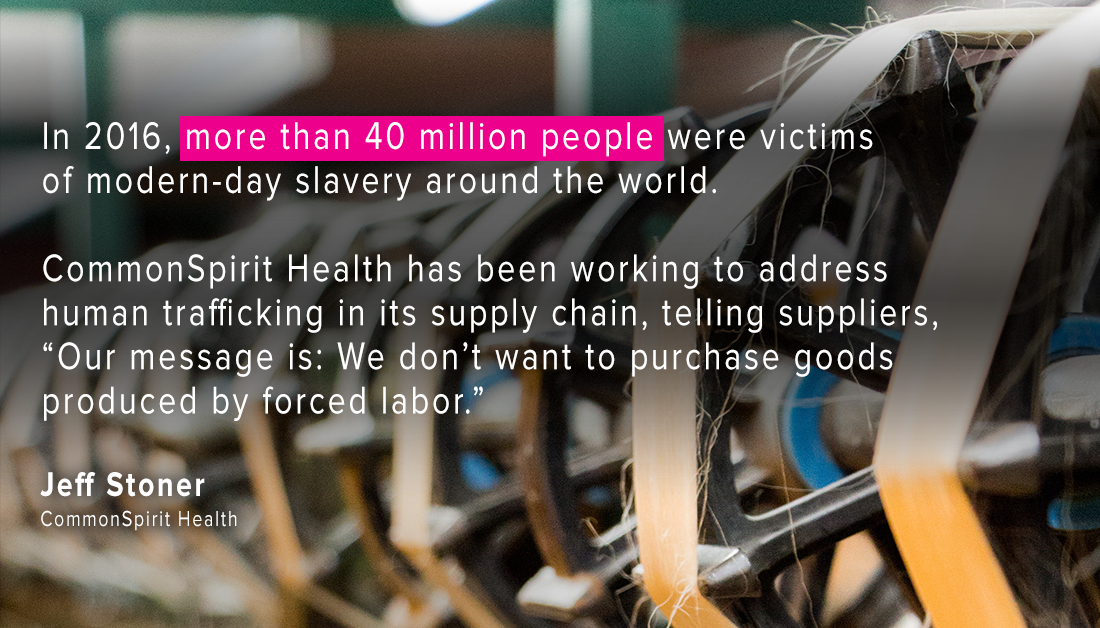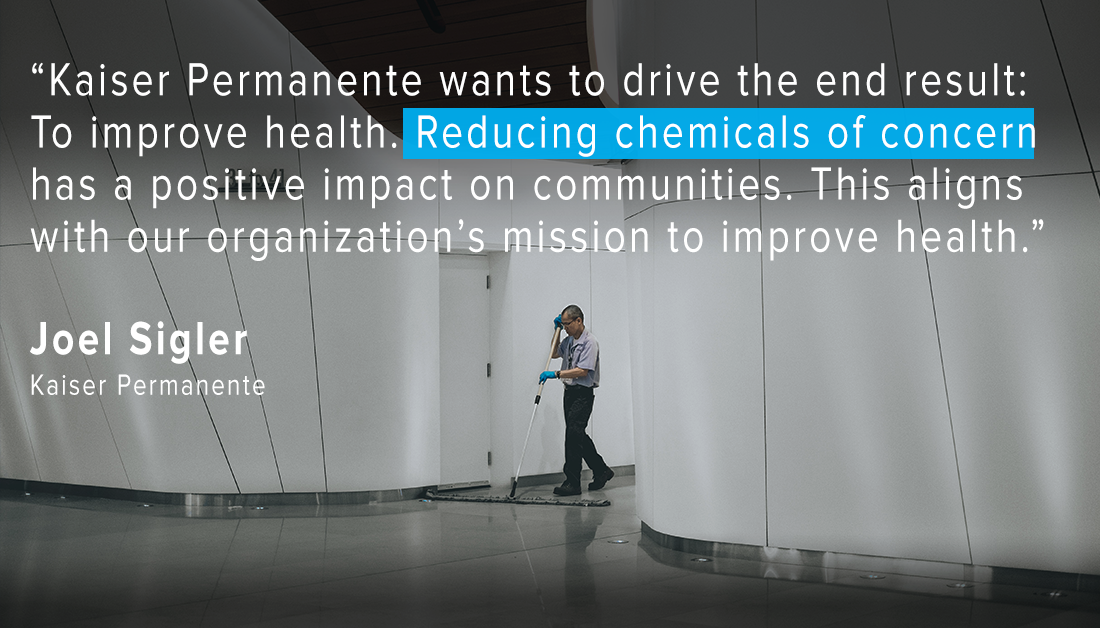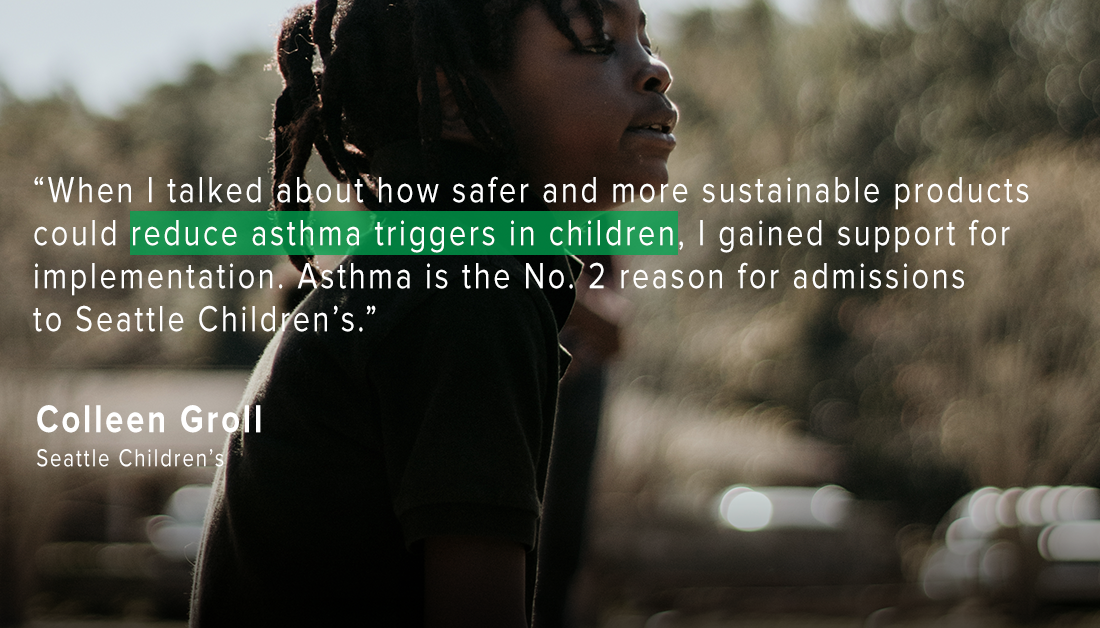11 hospitals healing health care through sustainable purchasing


More than 70% of a health system’s greenhouse gas emissions are embedded in the products and services they buy. As a resource-intensive industry with enormous buying power and the only industry with healing as its mission, health facilities are using sustainable procurement as a key action area for financial sustainability and for the benefit of patients, workers, the community, and the planet.
Featured in the groundbreaking new purchasing guide for health care, these 11 Practice Greenhealth member hospitals exemplify the many components of sustainable procurement, from eliminating toxins and forced labor, to supplier relations and local sourcing. Together, these practices have the power to drive us forward to a cleaner, more equitable economy in the 21st century and beyond.
Advocate Aurora Health
At Advocate Aurora Health, all procurement professionals are accountable for sustainable procurement goals and priorities. Collective goals are established, such as a target percentage of meat raised without antibiotics purchased per year or furniture that meets Practice Greenhealth’s healthy interior purchasing goals.
A dashboard is used to align personal and departmental goals. Collecting the data drives the achievement of new goals and ensures the organization is not losing ground in areas where targets have already been met, such as third-party certified sustainable cleaning products.
“The breadth of environmental, health, community, and labor issues and considerations [in the supply chain] is a major challenge. It is complex and multifaceted. This complexity makes focus and prioritization so necessary. There is no one particular place to start, but you have to start somewhere and build on that.” - Mary Larsen, Advocate Aurora Health director of environmental health and sustainability
Cleveland Clinic
According to Jon Utech, Cleveland Clinic Office for a Healthy Environment senior director, although almost all of their contracts contain clauses requiring suppliers to report sustainability criteria and outcomes, the health system aims to be very deliberate about the data they request, manage, and analyze. For example, they prioritize data on categories such as local food, furniture, and computers. Cleveland Clinic is cautious not to burden their supply chain with reporting requirements that will not be put to good use. Instead, they measure and manage sustainable supply chain outcomes within a reasonable scope until data management and assessment systems become more robust.
CommonSpirit Health

When figuring out how to begin this sustainable procurement work, Jeff Stoner, product line administrator, stated at CleanMed 2019, “(health care needs to) find out who the subject matter experts are, what has already been done, and gather the resources.”
Hackensack Meridian Health
“Since cost is always a key driver for supply chain, a best practice is to identify ways the organization can save money in order to engage supply chain leadership,” says Kyle Tafuri, Hackensack Meridian Health sustainability director. Tafuri identified financial wins and made sure the vice president of supply chain knew about them, including a renegotiated contract for waste management, a contract for pigment-free basins, and a surgical kit reduction initiative. As a result of identified cost savings, the vice president championed a sustainable procurement initiative for meat raised without routine antibiotics.
HealthPartners
HealthPartners found their strategy for sustainable procurement in their mission to improve the health and well-being of the community. When the sustainability team approached senior supply chain leadership, the business case had been established.
“Our CEO talks about sustainability. It’s our day-to-day fabric,” says Vini Manchanda, supply chain vice president. The mandate has also been established through an environmental procurement policy. With support from the vice president, the 2020 goals, and a clear policy directive, HealthPartners has the traction and accountability to implement sustainable procurement. According to Dana Slade, HealthPartners sustainability programs director, “formalizing the policy, procedures, and processes enables supply chain services to drive their own work.”
Kaiser Permanente

As part of its 2025 environmental stewardship goals, Kaiser Permanente aims to purchase 50% of products and materials that meet its environmentally preferable purchasing standards. This required the organization to identify appropriate standards to utilize in sourcing processes. When available, Kaiser Permanente uses credible, transparent third-party environmental certifications or standards. A lack of applicable certifications for medical products prompted Kaiser Permanente to develop an environmentally preferable purchasing standard to apply to this category. This standard details specific environmental criteria in the areas of chemicals and waste. In purchasing decisions, these criteria are evaluated in addition to other criteria such as quality, efficacy, assurance of supply, and outcomes.
Memorial Sloan Kettering Cancer Center
Memorial Sloan Kettering Cancer Center tracks sustainable purchasing efforts by utilizing third-party managed software for data collection. The facility ensures vendors know relevant data to report, such as spending on meat raised without antibiotics, and the importance of providing this data to support their business relationship. Every quarter, the spend data is compiled in structured dashboard reports, which are reviewed and evaluated by a cross-departmental team to address inconsistencies. The facility adopted specific food goals (local and sustainable food) and continually measures their success to communicate progress to internal stakeholders and senior leadership.
Seattle Children’s

Seattle Children’s engaged its supply chain to implement sustainable procurement with a benchmarking study and a focus on supporting children’s health. The project began with a team of two graduate students, who benchmarked the hospital’s environmental purchasing against leading programs that won Practice Greenhealth awards. A gap report demonstrated where Seattle Children’s ranked with others.
While the benchmarking study gave the supply chain department a desire to improve sustainable procurement performance, a focus on how procurement could support children’s health and well-being confirmed the value of their collaboration.
Sutter Health
Sutter Health’s chemicals advisory committee narrowed down contracts to prioritize by reviewing the work plan and speaking with supply chain representatives to assess timelines, milestones, and opportunities. The committee identified four contracts to prioritize and requested environmental criteria for each. The committee included internal and external technical expertise, such as from nonprofit organizations.
UC Health
UC Health, which includes six hospitals in California, identified sustainable food as an objective in their sustainable procurement strategy, and set a target to purchase 20% sustainable food by 2020. Hospital sustainability teams are tracking indicators on the amount of local food procured, purchases of sustainable foods carrying third-party certifications, and plant-based foods. They are also prioritizing purchases of compostable food service ware.
University of Maryland Medical Center
When evaluating expanded polystyrene (commonly referred to as Styrofoam) alternatives, the University of Maryland Medical Center engaged users from various areas of the hospital. They relied on feedback from users to determine whether proposed options met their needs (in this case, minimal “sweat,” durability, and insulation). They found a cup that not only met these needs but also their sustainable procurement goal for a product that could be recycled after use.
Along with these health systems, more than 43,000 hospitals and health systems are part of a global network committed to sustainable operations through Practice Greenhealth and Global Green and Healthy Hospitals.
The new sustainable procurement guide for health care features stories from 25 of these hospitals around the globe, and offers health care organizations a roadmap - for both new and existing sustainable procurement programs - to develop a sustainable purchasing strategy that prioritizes community and environmental health and safety while reducing costs.
Join Practice Greenhealth
Practice Greenhealth is the health care sector’s go-to source for information, tools, data, resources, and expert technical support on sustainability initiatives that help hospitals and health systems meet their health, financial, and community goals.
